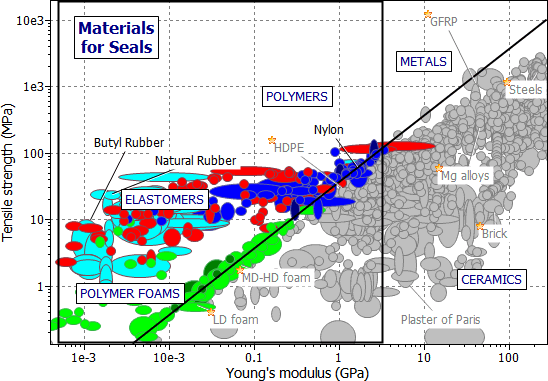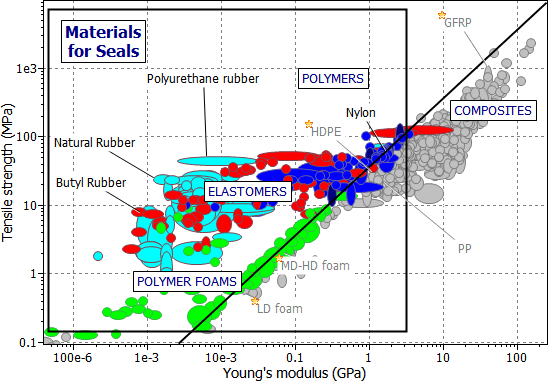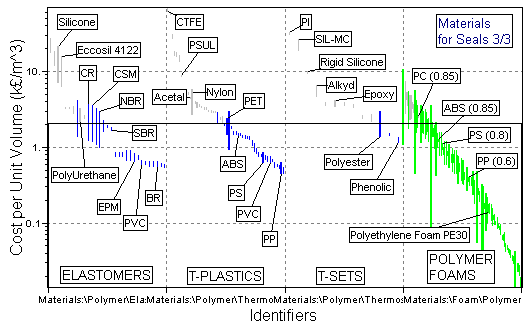.jpg)
A reusable static seal — the sort used in vacuum and pressure systems — consists of a cylinder of material compressed between two flat surfaces (Figure 11.1). The seal must form the largest possible contact width, b, while keeping the contact stress, s, sufficiently low that it does not damage the flat surfaces; and the seal itself must remain elastic so that it can be reused many times. What materials make good seals? Elastomers — everyone knows that. But let us do the job properly; there may be more to be learnt. Our starting point — the design requirements — are listed in Table 11.1.
.jpg)
Figure 11.1 A seal. Conformability measures the ability of the seal to adapt its shape to that of the surface.
FUNCTION |
Elastic seal |
OBJECTIVE |
Maximum conformability |
CONSTRAINTS |
(a) Limit on contact pressure |
(b) Low cost |
Table 11.1 The design requirements
A cylinder of diameter 2R and modulus E, pressed on to a rigid flat surface by a force f per unit length, forms an elastic contact area of width
 |
(M11.1) |
This is the quantity to be maximized: the objective function. The contact stress, both in the seal and in the surface, is adequately approximated by
 |
(M11.2) |
Now the constraint: the seal must remain elastic, that is, σ must be less than the yield or failure strength, σf, of the material of which it is made. Combining the last two equations with this condition and eliminating the 'free' variable f gives
 |
(M11.3) |
The contact width can therefore be maximized by maximizing the index
 |
(M11.4) |
This index measures conformability. The same index measures the ability of a seal to bed-down on to a surface with a wavy or irregular profile.
It is also required that the contact stress σ be kept low to avoid damage to the flat surfaces. For a given contact width b, the local stress σ is found by eliminating f from equations (M11.1) and (M11.2):
 |
(M11.5) |
The contact stress can therefore be minimized by selecting materials with low moduli, that is, with high values of
 |
An initial survey, is shown on the chart of tensile strength, σf, against Young's Modulus, E, in Figure 11.2 The search region is in the top left corner of the chart and it can be seen that elastomers, polymers and foams make the best static seals. Figure 11.3 uses the polymers record subset which contains polymers, elastomers, foams and composites. Possible choices are listed in Table 11.2 with commentary. If the surfaces to be sealed are hard and the contact pressure is not critical, then solid elastomers make the best seals (upper part of table). But if the surfaces are delicate, requiring low contact pressures, then soft elastomers and foams are the better choice.

Figure 11.2 A chart of tensile strength σf plotted against modulus, E, showing the indices M1 and M2.
The analysis highlights the functions that seals must perform: large contact area, limited contact pressure, environmental stability. Elastomers maximize the contact area; foams and cork minimize the contact pressure; PTFE and silicone rubbers best resist heat and organic solvents. The final choice depends on the conditions under which the seal will be used.

Figure 11.3 A chart of tensile strength σf plotted against modulus, E, using the polymer record subset, showing the indices M1 and M2.
MATERIAL |
 |
COMMENT |
Butyl rubbers |
1 – 3 |
The natural choice; poor resistance to heat and to some solvents |
Polyurethanes |
0.5 – 4.5 |
Widely used for seals |
Silicone rubbers |
0.1 – 0.8 |
Higher temperature capability than carbon-chain elastomers, chemically inert |
PTFE |
0.1 |
Expensive but chemically stable and with high temperature capability |
Polyethylenes |
0.05 – 0.2 |
Cheap |
Polypropylenes |
0.1 |
Cheap |
Nylons |
0.05 |
Near upper limit on contact pressure. |
Cork |
0.1 |
Low contact stress, chemically stable. |
Polymer foams |
up to 0.5 |
Very low contact pressure; delicate seals. |
Table 11.2 Materials for Reusable Seals
Finally, cost may also be a consideration. A ranking by cost is facilitated by the cost- material class chart shown in Figure 11.4, which also enables foams, or elastomers, or thermoplastics to be isolated if desired.

Figure 11.4 The material cost per unit volume, Cmρ, plotted, as a bar chart, as a function of material class, using the polymer record subset.
So much for static seals. Sliding seals can be quite different. They surround rotating shafts or moving piston-rods and are there to keep something in or out: hydraulic fluid, pressurized gas, unpleasant liquids, and so on. In these cases the tribological (friction and wear) properties of the seal material become important. Then carbon-bearing materials are widely used because of their low friction and wear rates and their chemical inertness.
Young, WC (1989) 'Roark's Formulas for Stress and Strain', 6th Edition, McGraw-Hill, NY, USA.
Johnson, KL (1985) 'Contact Mechanics', Cambridge University Press, Cambridge, UK
Mayer, E (1977) 'Mechanical Seals', Butterworth and Co, London, UK
Dahlheimer, JC (1972) 'Mechanical Face Seal Handbook', Chilton Book Co, UK
Thorwart, L (1994) 'Seals', Materials World, October issue, pp. 519–521.